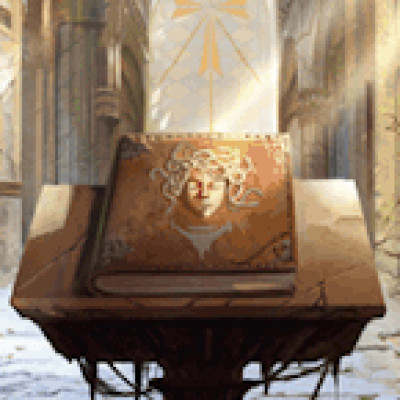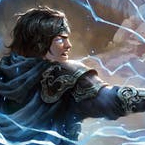When I made “Flesh and Blood is a Fighting Game” for the Gorganian Tome YouTube channel, I expected a great success to be 800 views. As of this writing, the video has surpassed 14 thousand. In effect, it was the most surprising thing to happen to me since I can remember.
The origins of the video are relatively benign: I had been playing Flesh and Blood for a long time, and really did not like that Oldhim was called a control deck, or Iyslander a combo deck. These terms bugged me, because they continued to try and cram Flesh and Blood as a game into a box in which it did not fit.
The reason I say it does not fit is a topic in and of itself, but let me briefly summarize:
It is my opinion that just because two games have a similar goal (in this case, "reduce your opponent's life total to zero), does not necessarily mean they have anything in common under the hood.
Card advantage in Flesh and Blood is not like card advantage in Magic, or Yu-Gi-Oh, or One Piece. Attacking with a Crippling Crush is innately good, even if it does no damage, because it forces cards to be used for something other than their best-use purpose.
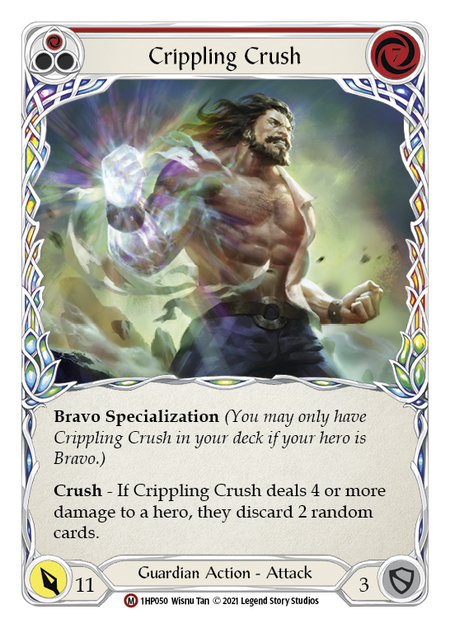
When I said this to myself, I thought, “oh, so does this mean that Crippling Crush is plus on block?” And the theory began to take hold.
"Plus on block" is a special fighting game term we’ll return to later, but for now, just know that “plus on block” is a very positive thing for a fighting game attack to have.
As I began developing the theory of relating it to fighting games, I found that there was much more I had not considered in terms of just how different FAB is from Magic. For example, I found in my searching for deck names that many are named after the Hero and a weapon or equipment: Axes Dori, Royal Viserai, Death Dealer Lexi, Sandscour Azalea. The titles themselves denote something about the Hero that, when played with a specific equipment piece or card, changes more about the deck than could be summed up in the language of "aggro” or “midrange.” Viserai is an especially good example. The Royal Viserai deck is a more aggressive version of the normal Viserai deck, but “Royal” denotes so much more than simply “Aggro Vis v1.2”. This runs in line with developing Fighting Game metas, in that there are some Dhalsim players who are known for being very aggressive Dhalsims, or very defensive Ryus - the language would simply break down if you attempted to apply it to a Fighting Game.
Further, I discovered that many deck builders and players already do not consider the hand-me-down archetypes of Magic as accurate to our game. To me, it is important that we, as a community, begin thinking about how we distinguish ourselves and our game from the wider TCG and Gaming world. Naming things gives them power, and simply adopting hand-me-down names, especially ones which do not do a good job of describing what’s happening in the game, has potential to cause damage to the understanding of our game for new players - and can breed confusion in the future for current players.
I do not mean that to sound so scary, or frightening. FAB, and its community, are already doing this. We already call Dash variants “Wombat” or “Treefrog.” We've greatly amplified the "Fatigue” strategy to one of the major FAB archetypes. These in-jokes and deep cut references are how a jargon, or nomenclature, is born. So while I think we will eventually attain a creole to talk about Flesh and Blood, my hope in creating the video - and these articles at the Rathe Times - is to help us more quickly cast off the old definitions from Magic, and instead think critically about our game as an end in itself.
With that, let us start by recapping some important big-picture points from the video.
Flesh and Blood inspires a deep sense of player/character identity
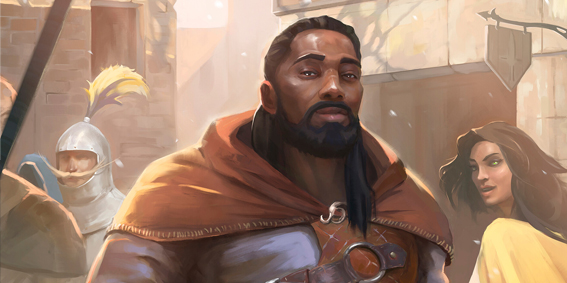
We all have that friend at the LGS. They play Boltyn. They talk about Boltyn. They complain about Boltyn. They know every card possible to play in Boltyn. They even kind of look like Boltyn if you catch them at the right angle. Boltyn, as a character, has captured the imagination of many a Flesh and Blood player, so much so that Boltyn is almost an extension of their personality. They enjoy the underdog, or the idea that it is “me and Boltyn, against the world.”
This extended idea of player and player-character is actually quite rare in other card games. Sure, in Magic we have Reid Duke known as the Jund player, but the archetype of deck does not carry the same weight. Being a “midrange” player does not carry that sense of personality like in FAB. I often feel like I can walk in a room and tell who each person plays based on how they dress, or their mannerisms. Is there someone smirking in the corner? Well, they play Kano.
So too, in Fighting Games, the player identity is wrapped up in the player character. When I started playing Street Fighter 5, for example, I chose Karin Kanzuki as my main for that game. Very quickly, I discovered a whole host of professional players who also play Karin, and they became my professors. Punk, Phenom, Bonchan, Justin Wong, etc. I followed them very closely, studying how they dealt with any given situation, so that I may replicate it in my ladder matches. My friend plays “the grappler” in any fighting game, but his favorite of all characters, I would argue, is “Zangief.” If you were to meet my friend, you would assume he plays Zangief. He just looks like a Zangief player.
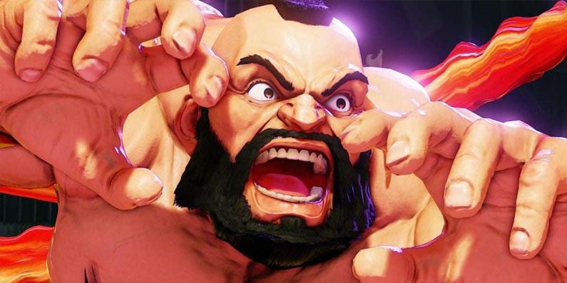
I mapped this directly onto my FAB journey, where once I decided Dromai was my character, I quickly found Jamie Faulkner, Ian Zhang, and then later Mara Faris. I still go back and watch match footage of Jamie and Ian and how they navigate complicated scenarios, because they are so good at the Big Dragon Dromai variant of the deck.
And there is someone like this for every hero. Do you like Iyslander? Check out James Adams or Ethnic Smoke or Michael Hamilton. Levia? Man Sant. Fai? George Rodger or Daniel Rutkowski. The list of heroes and players goes deep. And while, yes, one could do the same with other TCGs, I still maintain that LSS has fostered this emotional connection to the character better than any other card game, and that is as a result of my next point.
No Two Heroes Play Alike
Dorinthea and Boltyn, Rhinar and Levia, Prism and Dromai, Fai and Katsu, Kano and Iyslander, Briar and Chane, Oldhim and Bravo. What these pairs of heroes share with one another is their class. Kano and Iyslander are both Wizards - but a Kano player will not necessarily enjoy playing Iyslander and vice versa. Each of these characters has very unique gameplay patterns, strategies, and goals.
This, I cannot stress enough, is unique. When I was a Magic player, I played midrange decks. I love midrange decks. I can play any midrange deck. It doesn't matter what the colors of the midrange deck are, as long as it is midrange. This is because I was married to the “archetype” of midrange, not something innate about any one deck.
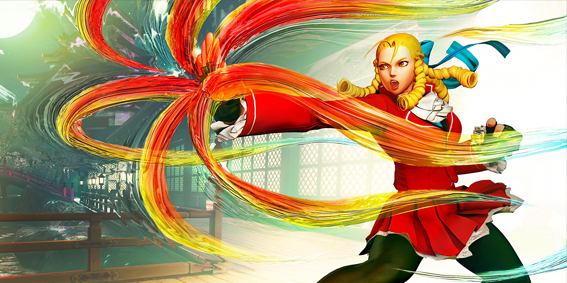
Conversely, in Street Fighter 5, I played Karin, Karin, Karin. And sometimes Guile as my pocket character (a pocket is a backup in the Fighting Game Community). Karin is considered a "footsie-based rushdown character". There are so many footsie-based rushdown characters in fighting games, I had no lack of options. I could have played Rashid, Cammy, Luke, Ken, Necalli, Balrog, Juri, Urien, Kolin, Ed, and so on. But none of those characters “fit my hands,” to borrow a quote from the ineffable Gerald from Core-A Gaming YouTube channel. I only played Karin, because I only had enough time to play one.
Karin, like every other character in Street Fighter, is a full game unto herself. It is one thing to know all of Karin’s combo strings, it’s a whole other thing to understand her combo strings against every other character in the cast, because, for the most part, each offensive moveset changes slightly depending on my opponent’s Offensive and Defensive capabilities.
Likewise, in FAB, I play Dromai, Fai, and Uzuri. Dromai is my main, Uzuri is my pocket, and Fai is the deck I play when my LGS gets a bit too overrun by Dromai. Dromai is complicated enough that I do not need anything else. If I am competing, I am playing Dromai (until she reaches living legend - which, if you trust Roger Bodee, will never happen!)
I hope you can see my logic here. That emotional connection is a strong pull in the direction of a character in both FAB and Fighting Games. One cannot commit to losing so much in the beginning without loving who they play.
Why FAB Characters fit so well within Fighting Game Archetypes
As I had stated in my Gorganian Tome video, the traditional triangle of card games - as defined by Magic and applied widely across other card games - is “Aggro, Combo, and Control.” Magic works on a few axes - number of life points, number of cards, number of resources - and these archetypes have clearly defined goals across these axes.
Aggro trades resources for life points.
Control trades life points for cards and resources.
Combo trades life points for cards (specifically, the right cards).
If I play as an aggro deck, I am attempting to pressure the life total before the control player gets enough resources. If I am playing a control deck, I am trying to stop the aggro player from getting their critical mass of life point threats. If I am control against combo, I am trying to stop their cards from coming together.
The archetypes in Magic all revolve around these axes of victory. Obviously it's more complicated than that, but this is a decent baseline to understand the very core of Magic as a game.
In Fighting Games, we do not use Aggro, Combo, or Control (nor do we use Midrange, the 'center' of the archetypical triangle of Magic). The archetypes of Fighting Games are Rushdown, All-Rounder, Zoner, and Grappler.
If I play as a Rushdown character, my goal is to force my opponent into as many mistakes as possible. I will utilize my tricky offensive tools to make them think I am attacking high, when I am really attacking low. I will do a safe jump in the hopes they try to punish it, so I can punish their punish and do a heap of damage as a result.
If I am a Grappler, I will use my defensive capabilities to land critical grabs, which require me to be very close to my opponent. My whole goal is to utilize my evasive damage and force awkward situations for my opponent, because they cannot block my grabs like regular attacks.
If a Zoner is achieving their goal, the opponent will give up trying to get in and attack the zoner directly; rather, they must commit time and mental power to trying to hit the long range attacks of the zoner, or try to navigate the minefield of traps they leave (I’m looking directly at you, Testament, from Guilty Gear Accent Core Plus R).
If I am an All-Rounder, I can slide my scale between offense and defense depending on the situation, matchup, etc.
What is important to note here, too, is that all of these characters are more fluid. A rushdown will likely have to play very defensively at some point. A grappler may throw caution to the wind and start bashing their opponent over the head as fiercely as possible. A zoner may need to set up a nasty combo to deal significant damage if they are behind in life coming toward the end of the round.
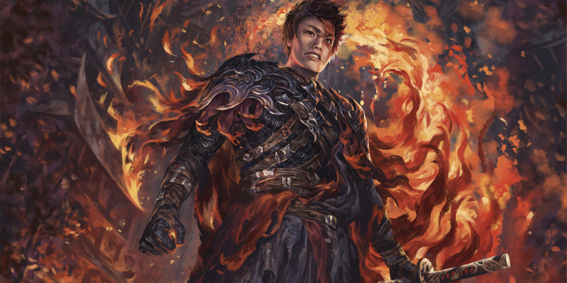
As an obvious example, Fai is a Rushdown. Fai is explosive. You never quite know when his 4 attack combat chain could turn into a 7 attack combat chain with multiple draw effects, an Art of War, +1s galore on his Draconic chain links. Or Briar, who “powers up,” with a Channel Mount Heroic to significantly increase her damage output. Regardless, though, it is quite rare for a skilled rushdown player to kill because of a huge combo string; rather, they are trying to put pressure on the axis that works best for them: life. The actual goal of the rushdown player is to reduce their opponent’s life total enough that they must commit cards to block every turn, which has the knock-on effect of making their own turn weaker. If I'm defending as Bravo, and I have a Crippling Crush with three blues in hand, each attack from a Fai will force me to reconsider how I will do my offense, if I can at all.
This tracks well with Fighting Games, where a skilled rushdown player in a fighting game is also trying to pressure the life total as fast an efficiently as possible, so that they can be closed out safely. If I am playing as Jamie in Street Fighter 6, my hope is to pressure my opponent’s life total enough that I can commit my absolute safest options to force a kill. My opponent, who can no longer trade their life total for their own damage, is forced into blocking everything, and trying to deal as much damage as possible with each hit, because the game is astoundingly dangerous for them now.
We can map this to every archetype well, but I will keep it short because I intend to cover these more in later articles.
As Uzuri, I can pretty safely block with two cards and attack with 2 cards every turn, while maintaining an efficient damage curve. Uzuri can pivot on a dime. This, in my theory, translates well to the All-Rounder category, which I detailed a bit earlier with Ryu. Uzuri is all about reading the situation and determining whether defense or offense is better.
Bravo is a character I define as a grappler because of his evasive damage and terrifying on-hit effects. My mechanical goal is to protect my life total vigilantly until I see an opening for huge damage. Ultimately, my hope is to force my opponent into a dominated attack range and close them out evasively.
Dromai is the current resident Zoner, whose goal is to trade her life for board state. The reason Dromai is so dangerous is specifically because, outside of a few characters, there is no efficient way to kill her dragons. Each Dragon attacked is life gained for Dromai. She is not so much trying to defend like Bravo; much more so that she is trying to make her opponent “give up” attacking her, at which point she can chip away at their life. She’s like a boa constrictor, squeezing her opponent to death with advantage. If you ever play as or against a zoner in a fighting game, this linkage will become so apparent. Dhalsim has, effectively, the best attacks in the game. They do great damage, and most of them hit across the entire screen.
Stretching the Comparison
Despite the title of my video, I, of course, do not think Flesh and Blood is literally a Fighting Game. In one game, one plays with cards, in the other game, a fight stick or controller. They are different. But the argument I wanted most to make, is the underlying mechanics and goals of both games are similar enough that they warrant closer inspection (which is a terrible title for a YouTube Video).
One of my biggest hurdles in developing this theory is that of the card economy and fatigue. In a Fighting Game, you never run out of punches, kicks, and special moves. There is no finite number of Head Jabs. If you spend your special meter, it usually recharges. As I pondered late into the night, wondering how this could still fit within the confines of the archetype, I came up with some answers that satisfy me enough.
So then, how do we get around this fatigue problem? I look to Street Fighter 6 for that. The special meter in Street Fighter 6 is an ever-shifting dance based on what the two characters are doing. If I come out swinging with reckless abandon, spending all my meter, I will enter a state called “Burnout” in which I can no longer extend certain combo strings with overdrive abilities. In this state, I can also be stunned (my character will not respond to my inputs), and I also cannot parry attacks. I have used all my resources, and I simply must wait for the meter to return.
Being in burnout does not mean I lose the game on the spot, though. It is actually often the case that pro players are burning their meter out intentionally so that they can then commit to a huge attack, which will give them enough time to recharge their meter; or they will spend the meter and go into burnout in order to get those last few points of damage through.
We haven't ventured outside of Street Fighter yet, but there's a good opportunity here if we jump over to Guilty Gear -Strive-. In Strive, there is a mechanic called the “Roman Cancel.” A Roman Cancel is, in effect, a button one can press which allows them to extend combos that are otherwise not possible. In Strive, one can have a maximum of two cancels stocked for such occasions. If they spend a stock, they have to rebuild it over the course of the match. (These stocks can also be used defensively, too, but that’s another topic for another day.)
It is the case, again, that I can kill someone without any stocks of meter for my Roman Cancels. Just as it is the case that I can kill someone with my blue cards and not my reds. Certain characters are better at it than others, and now I am hoping you can see the pattern here. There is an elasticity in the design of both games which solve for the problem of fatigue as it transfers from one to another.
In Magic, if I run out of cards in hand, I am at the behest of the gods to grant me a good top deck. If I draw a land instead of a creature, I lose. There is no other play pattern. There is no special meter or pitch stack or sand-bag. Draw the card, or don’t. And that is why, even in the tertiary mechanics of the game, I maintain that Flesh and Blood is more like a Fighting Game, a game in which it is not over until you see the K.O. splash the screen (or Pablo Pintor’s impressive wink game at Calling Antwerp) that the game is done and dusted.
Next time, I plan to do a deep dive on each character pool, and provide some analogues in the FGC for players to get a taste of what they can learn if they play both games, like I do. Until then, see you on Twitter @GorganianTome or on YouTube by the same name.


